An Electrochemical Evaluation of Novel Ferrocene Derivatives for Glutamate and Liver Biomarker Biosensing
Abstract
:1. Introduction
2. Experimental
2.1. Reagents
2.2. Apparatus
2.3. Procedures
- Synthesis of 3-(1H-pyrrol-1-yl)propanoic acid (1) [18]
- Synthesis of 3-(1H-pyrrol-1-yl)propanamidoferrocene (2)
- Synthesis of Cyano(trimethylsilyloxy)methylferrocene (3)
- Synthesis of 2-amino-1-hydroxyethylferrocene (4)
- Synthesis of 3-(2-bromoethyl)thiophene (5)
- Synthesis of 1-hydroxy-2-[2-(thiophen-3-yl)-ethylamino]ethylferrocene (6)
- Preparation of Glutamate oxidase electrodes
- Solution-mediated electrochemical detection of l-glutamate
- Electropolymerisation of Fc derivatives and Pyrrole/EDOT by Potential Sweeping
- Mediated electrochemical detection of l-glutamate
- Unmediated electrochemical detection of γ-glutamyltranspeptidase using cyclic voltammetry and chronoamperometry
- Mediated electrochemical detection of GTP using cyclic voltammetry
3. Results and Discussion
Solution Phase Mediated Electrochemical Detection of l-Glutamate
2Fc → 2Fc+ + 2e−
- Mediated detection of l-glutamate using (3-(1H-pyrrol-1-yl)propan amido)ferrocene (2) and 1-hydroxy-2-[2-(thiophen-3-yl)-ethylamino]ethylferrocene (6)
- Polymerisation of 3-(1H-pyrrol-1-yl)propanamidoferrocene (2) and pyrrole using cyclic voltammetry
- Polymerisation of 1-hydroxy-2-[2-(thiophen-3-yl)-ethylamino]ethylferrocene (6) and EDOT using cyclic voltammetry
4. Conclusions
Author Contributions
Funding
Institutional Review Board Statement
Informed Consent Statement
Data Availability Statement
Conflicts of Interest
References
- Degrand, C.; Limoges, B.; Rapicault, S. Enzyme Immunoassay Technique Using Alkaline Phosphatase Enzyme Labels and A Nafion Electrode As Sensor. J. Pharm. Biomed. Anal. 1996, 14, 1343–1349. [Google Scholar] [CrossRef]
- Limoges, B.; Degrand, C. Ferrocenylethyl Phosphate: An Improved Substrate for The Detection of Alkaline Phosphatase by Cathodic Stripping Ion-Exchange Voltammetry. Application to the Electrochemical Enzyme Affinity Assay of Avidin. Anal. Chem. 1996, 68, 4141–4148. [Google Scholar] [CrossRef] [PubMed]
- Borisova, T.; Kucherenko, D.; Soldatkin, O.; Kucherenko, I.; Pastukhov, A.; Nazarova, A.; Galkin, M.; Borysov, A.; Krisanova, N.; Soldatkin, A.; et al. An Amperometric Glutamate Biosensor for Monitoring Glutamate Release from Brain Nerve Terminals and in Blood Plasma. Anal. Chim. Acta 2018, 1022, 113–123. [Google Scholar] [CrossRef]
- Isoaho, N.; Peltola, E.; Sainio, S.; Koskinen, J.; Laurila, T. Pt-Grown Carbon Nanofibers for Enzymatic Glutamate Biosensors and Assessment of Their Biocompatibility. RSC Adv. 2018, 8, 35802–35812. [Google Scholar] [CrossRef] [Green Version]
- Hughes, G.; Pemberton, R.M.; Fielden, P.R.; Hart, J.P. The Design, Development and Application of Electrochemical Glutamate Biosensors. TrAC Trends Anal. Chem. 2016, 79, 106–113. [Google Scholar] [CrossRef]
- Huang, X.-J.; Im, H.-S.; Lee, D.-H.; Kim, H.-S.; Choi, Y.-K. Ferrocene Functionalized Single-Walled Carbon Nanotube Bundles. Hybrid Interdigitated Construction Film for l-Glutamate Detection. J. Phys. Chem. C 2007, 111, 1200–1206. [Google Scholar] [CrossRef]
- Chen, J.; Yu, Q.; Fu, W.; Chen, X.; Zhang, Q.; Dong, S.; Chen, H.; Zhang, S. A Highly Sensitive Amperometric Glutamate Oxidase Microbiosensor Based on a Reduced Graphene Oxide/Prussian Blue Nanocube/Gold Nanoparticle Composite Film-Modified Pt Electrode. Sensors 2020, 20, 2924. [Google Scholar] [CrossRef]
- Na Nakorn, P.; Suphantharika, M.; Udomsopagit, S.; Surareungchai, W. Poly(Vinylferrocene)–Poly(Ethylene Glycol) Glutamate Oxidase Electrode for Determination of l-Glutamate in Commercial Soy Sauces. World J. Microbiol. Biotechnol. 2003, 19, 479–485. [Google Scholar] [CrossRef]
- Batra, B.; Yadav, M.; Pundir, C.S. l-Glutamate Biosensor Based on l-Glutamate Oxidase Immobilized onto Zno Nanorods/Polypyrrole Modified Pencil Graphite Electrode. Biochem. Eng. J. 2016, 105, 428–436. [Google Scholar] [CrossRef]
- Batra, B.; Kumari, S.; Pundir, C.S. Construction of Glutamate Biosensor Based on Covalent Immobilization of Glutamate Oxidase on Polypyrrole Nanoparticles/Polyaniline Modified Gold Electrode. Enzym. Microb. Technol. 2014, 57, 69–77. [Google Scholar] [CrossRef]
- Batra, B.; Pundir, C.S. An Amperometric Glutamate Biosensor Based on Immobilization of Glutamate Oxidase onto Carboxylated Multiwalled Carbon Nanotubes/Gold Nanoparticles/Chitosan Composite Film Modified Au Electrode. Biosens. Bioelectron. 2013, 47, 496–501. [Google Scholar] [CrossRef]
- Ikegami, Y.; Hozumi, S.; Shoji, A.; Hirano-Iwata, A.; Bliss, T.; Sugawara, M. Real-Time Monitoring of Extracellular l-Glutamate Levels Released by High-Frequency Stimulation at Region Ca1 of Hippocampal Slices with a Glass Capillary-Based l-Glutamate Sensor. Sens. Bio-Sens. Res. 2014, 2, 31–37. [Google Scholar] [CrossRef] [Green Version]
- Jamal, M.; Worsfold, O.; Mccormac, T.; Dempsey, E. A Stable and Selective Electrochemical Biosensor for the Liver Enzyme Alanine Aminotransferase (Alt). Biosens. Bioelectron. 2009, 24, 2926–2930. [Google Scholar] [CrossRef] [PubMed]
- Kuntz, E.; Kuntz, H.-D. Hepatology Textbook And Atlas; Springer: Berlin/Heidelberg, Germany, 2008. [Google Scholar]
- Li, L.; Shi, W.; Wu, X.; Gong, Q.; Li, X.; Ma, H. Monitoring Γ-Glutamyl Transpeptidase Activity and Evaluating Its Inhibitors by a Water-Soluble Near-Infrared Fluorescent Probe. Biosens. Bioelectron. 2016, 81, 395–400. [Google Scholar] [CrossRef]
- Upadhyay, S.; Ohgami, N.; Kusakabe, H.; Suzuki, H. Electrochemical Determination of Gamma-Glutamyl Transpeptidase Activity and Its Application to A Miniaturized Analysis System. Biosens. Bioelectron. 2006, 21, 1230–1236. [Google Scholar] [CrossRef] [PubMed]
- Morimoto, K.; Upadhyay, S.; Higashiyama, T.; Ohgami, N.; Kusakabe, H.; Fukuda, J.; Suzuki, H. Electrochemical Microsystem With Porous Matrix Packed-Beds for Enzyme Analysis. Sens. Actuators B Chem. 2007, 124, 477–485. [Google Scholar] [CrossRef]
- Le-Poul, N.; Green, S.J.; Attfield, J.P.; Bedford, R.B.; Lyons, M.E.; Patterson, A.M. Sub-Tc Electron Transfer at the Htsc/Polymer Interface. Chem. Commun. 2003, 638–639. [Google Scholar] [CrossRef] [PubMed]
- Forrow, N.J.; Sanghera, G.S.; Walters, S.J. The Influence of Structure in the Reaction of Electrochemically Generated Ferrocenium Derivatives with Reduced Glucose Oxidase. J. Chem. Soc. Dalton Trans. 2002, 3187–3194. [Google Scholar] [CrossRef]
- Tustin, G.J.; Lafitte, V.G.H.; Banks, C.E.; Jones, T.G.J.; Smith, R.B.; Davis, J.; Lawrence, N.S. Synthesis and Characterisation of Water Soluble Ferrocenes: Molecular Tuning of Redox Potentials. J. Organomet. Chem. 2007, 692, 5173–5182. [Google Scholar] [CrossRef]
- Shokuhi Rad, A.; Esfahanian, M.; Ganjian, E.; Tayebi, H.-A.; Novir, S.B. The Polythiophene Molecular Segment As a Sensor Model For H2O, HCN, NH3, SO3, and H2S: A Density Functional Theory Study. J. Mol. Model. 2016, 22, 127. [Google Scholar] [CrossRef]
- Huang, Y.; Wang, W.; Li, Z.; Qin, X.; Bu, L.; Tang, Z.; Fu, Y.; Ma, M.; Xie, Q.; Yao, S.; et al. Horseradish Peroxidase-Catalyzed Synthesis of Poly(Thiophene-3-Boronic Acid) Biocomposites for Mono-/Bi-Enzyme Immobilization and Amperometric Biosensing. Biosens. Bioelectron. 2013, 44, 41–47. [Google Scholar] [CrossRef] [PubMed]
- Nguyen, H.H.; Kim, M. An Overview of Techniques in Enzyme Immobilization. Appl. Sci. Converg. Technol. 2017, 26, 157–163. [Google Scholar] [CrossRef]
- Xu, K.; Chen, X.; Zheng, R.; Zheng, Y. Immobilization of Multi-Enzymes on Support Materials for Efficient Biocatalysis. Front. Bioeng. Biotechnol. 2020, 8, 660. [Google Scholar] [CrossRef] [PubMed]
- Wang, Z.; Mohwald, H.; Gao, C. Preparation And Redox-Controlled Reversible Response of Ferrocene-Modified Poly(Allylamine Hydrochloride) Microcapsules. Langmuir 2011, 27, 1286–1291. [Google Scholar] [CrossRef] [PubMed]
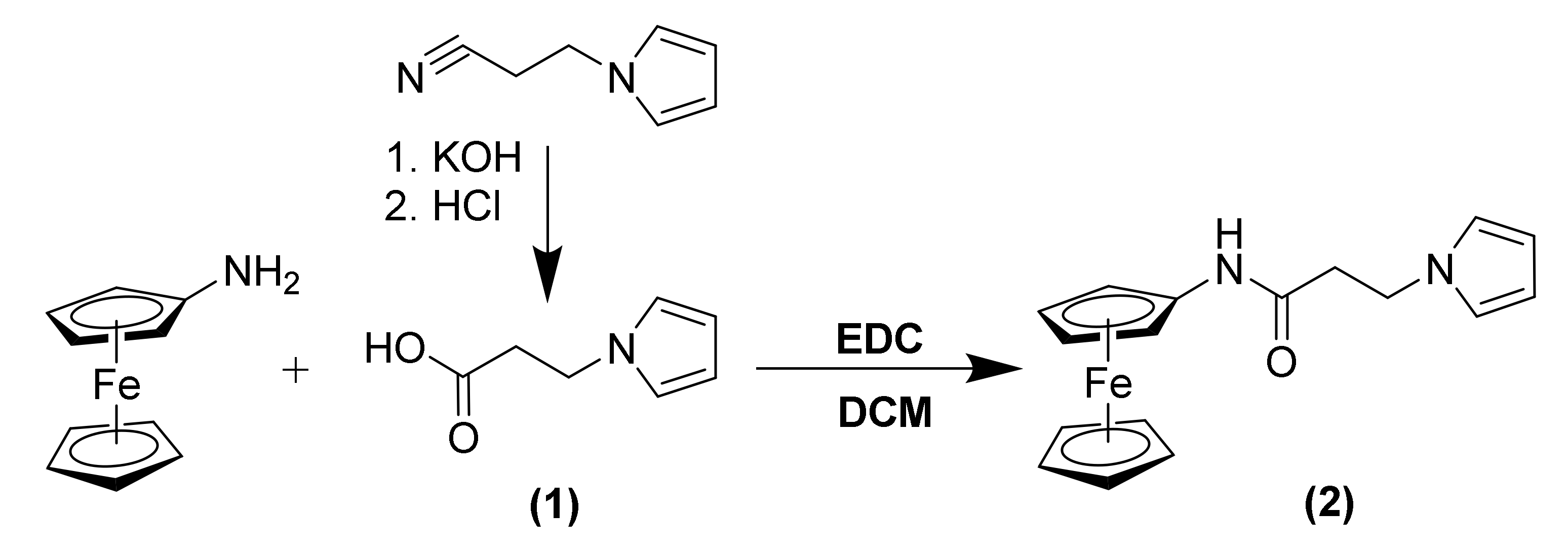



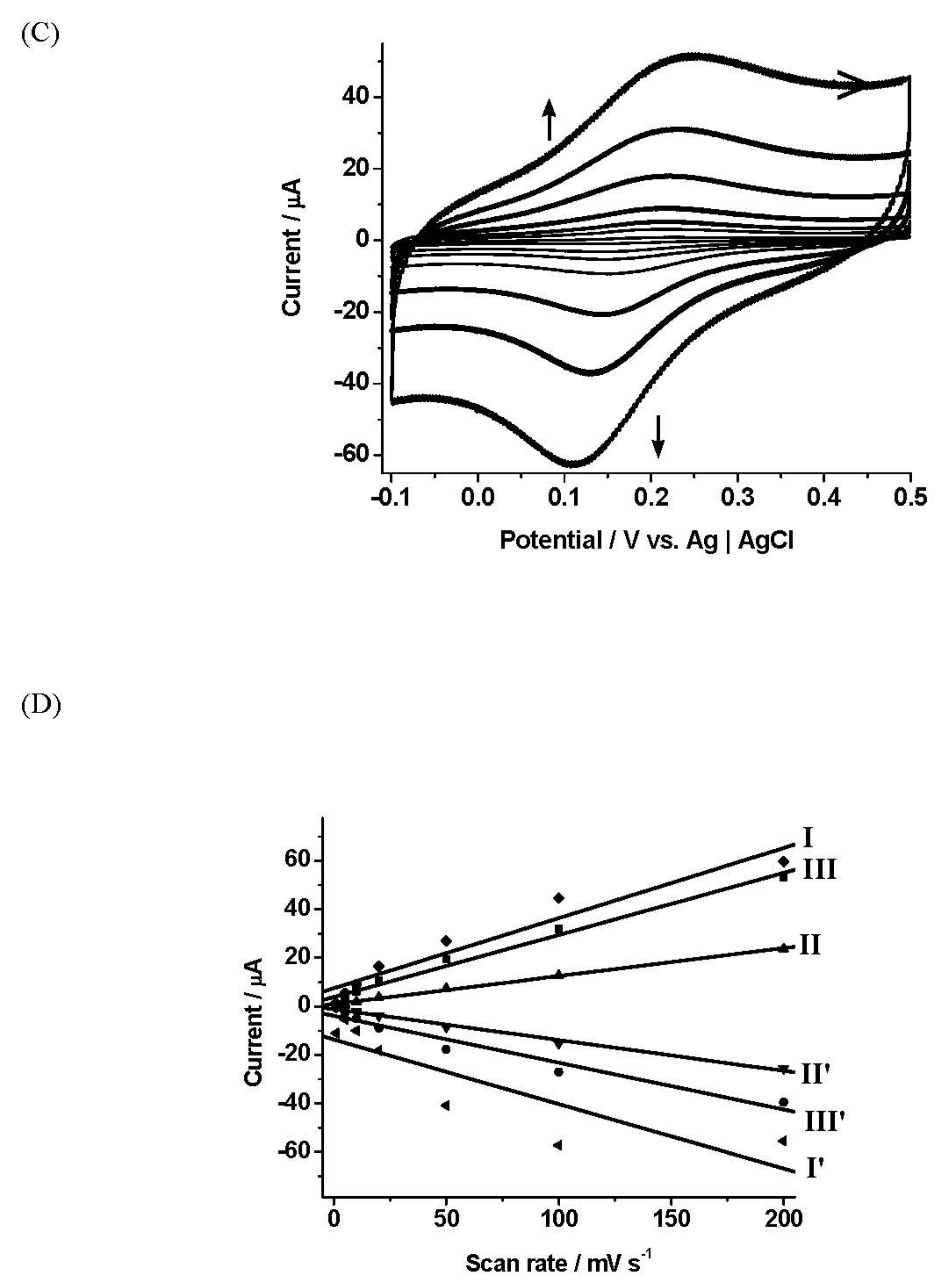
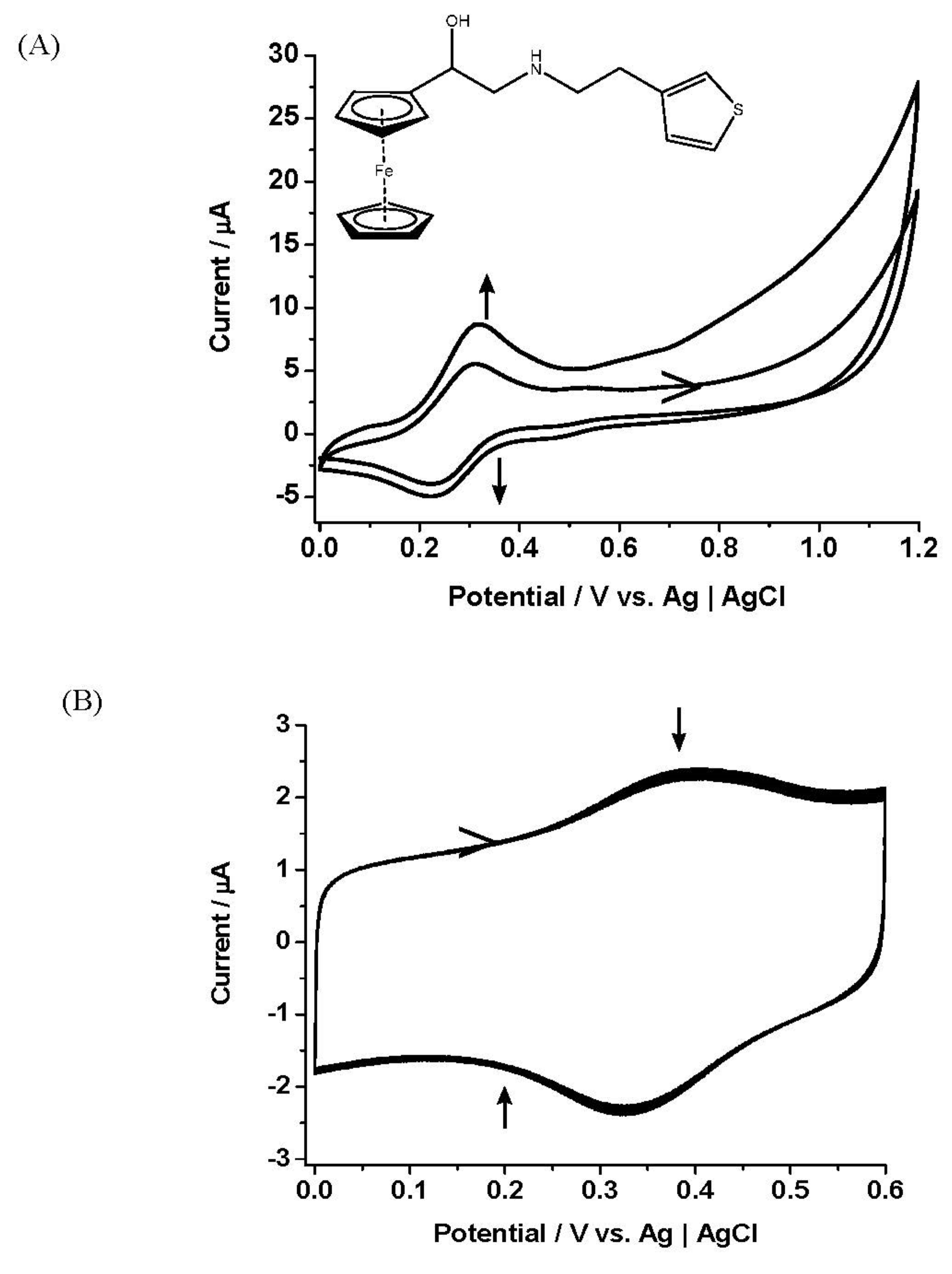

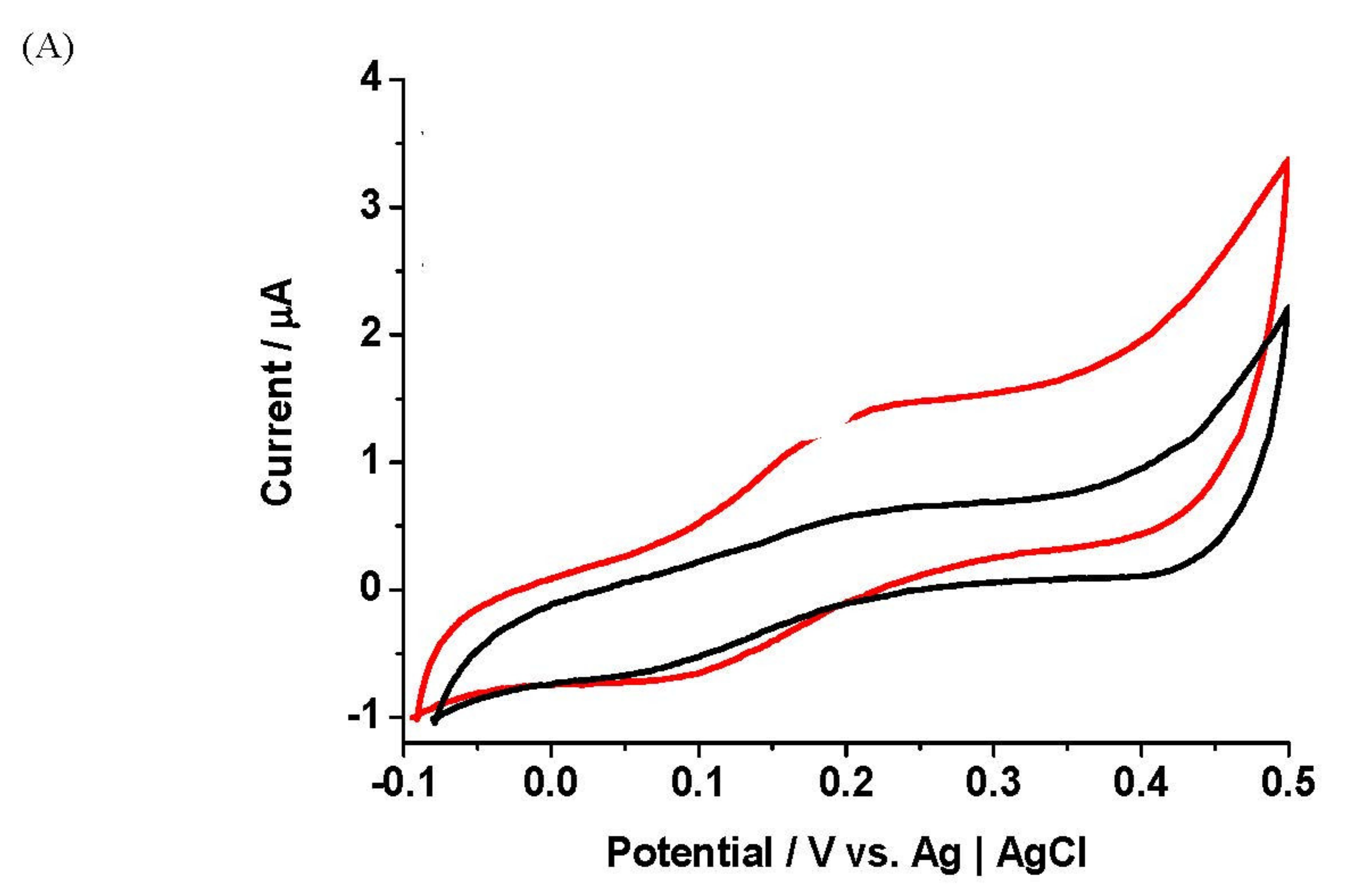
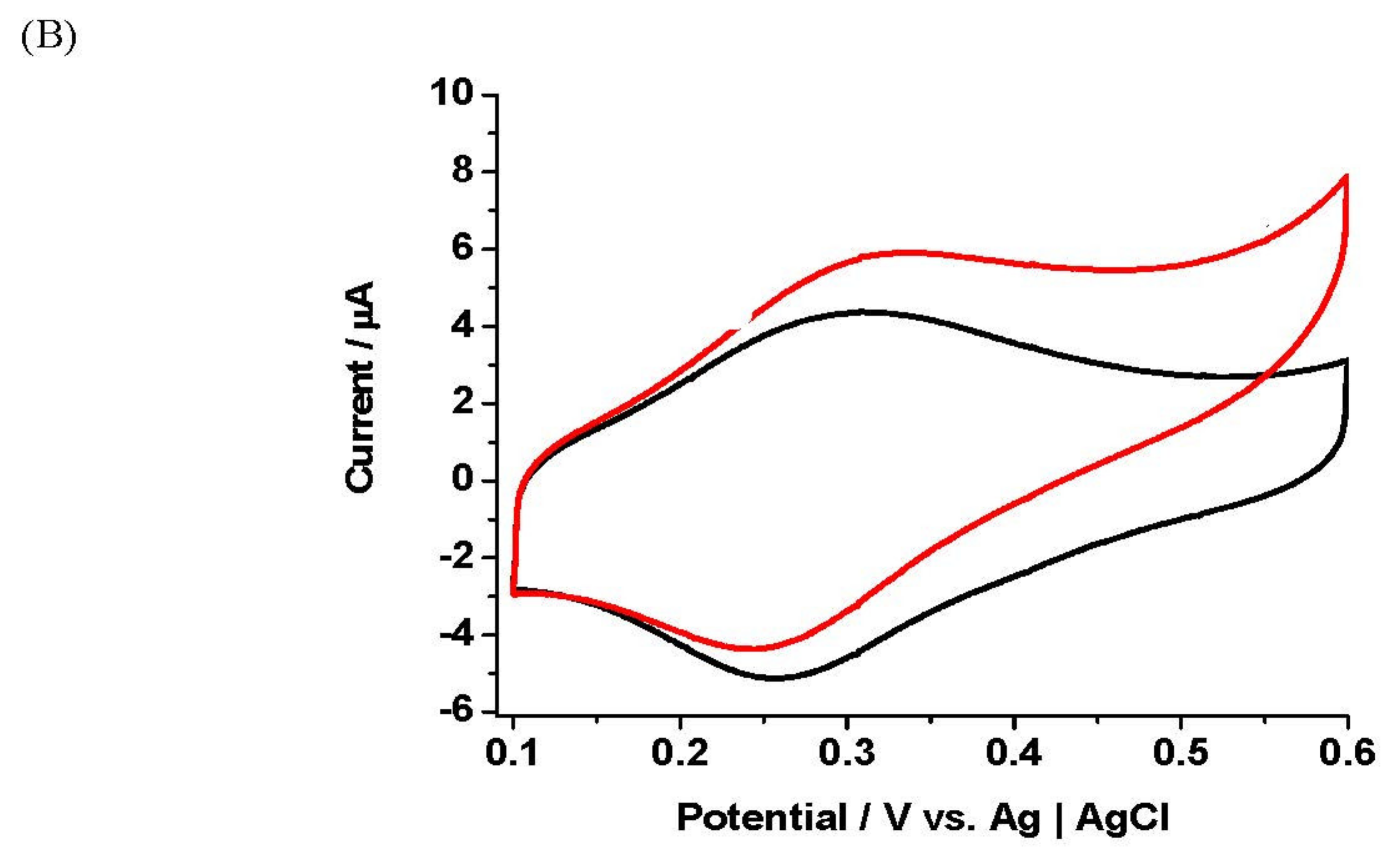
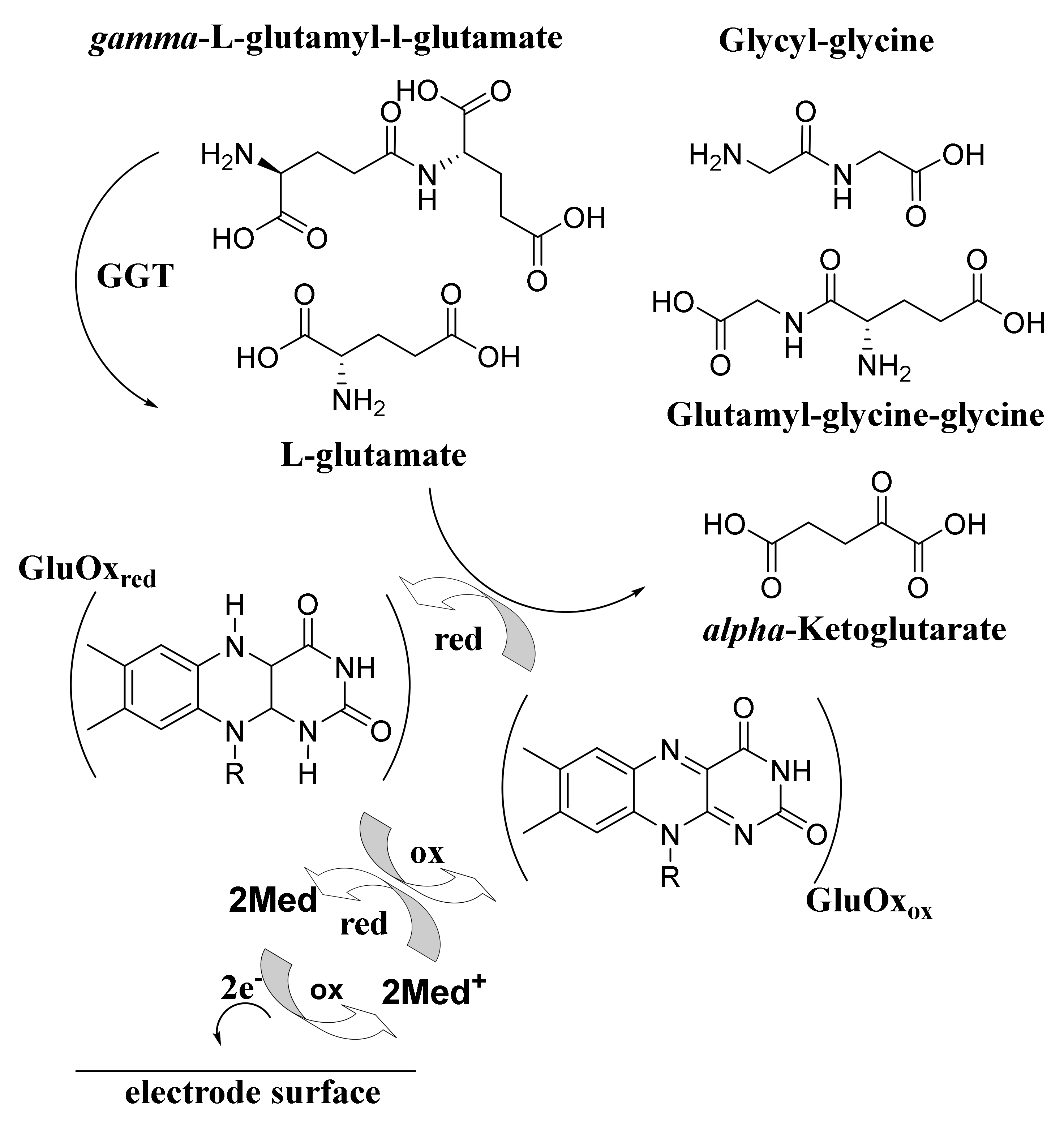

| Ratio of Fc:pyrrole (mM) | 109 Γ (mol cm−2) | ipa Loss (%) | ipc Loss (%) | Scan Rate (mV s−1) | ΔEp (mV) | E1/2 (mV) | FWHMox (mV) | FWHMred (mV) |
|---|---|---|---|---|---|---|---|---|
| 1:1 (1 mM:1 mM) | 0.33 | 4.66 | 5.15 | 1 | 86 | 267 | 208 | 200 |
| 5 | 62 | 276 | ||||||
| 10 | 95 | 279 | ||||||
| 20 | 128 | 282 | ||||||
| 50 | 189 | 284 | ||||||
| 100 | 248 | 276 | ||||||
| 200 | 399 | 277 | ||||||
| 1:2.5 (1 mM:2.5 mM) | 0.14 | 3.73 | 2.30 | 1 | 104 | 217 | 224 | 168 |
| 5 | 135 | 230 | ||||||
| 10 | 187 | 236 | ||||||
| 20 | 232 | 235 | ||||||
| 50 | 325 | 228 | ||||||
| 100 | 371 | 225 | ||||||
| 200 | 407 | 224 | ||||||
| 1:5 (1 mM:5 mM) | 0.47 | 5.11 | 4.28 | 1 | 111 | 206 | 204 | 158 |
| 5 | 171 | 206 | ||||||
| 10 | 246 | 212 | ||||||
| 20 | 300 | 200 | ||||||
| 50 | 349 | 205 | ||||||
| 100 | 359 | 208 | ||||||
| 200 | 369 | 207 |
| (3-(1H-pyrrol-1-yl)propanamido) ferrocene (2)—pyrrole | |||
| Ratio of Fc:pyrrole (mM) | 10−9 DCT½C (mol cm−2 s−1/2) | α | ks (s−1) |
| 1:1 (1 mM:1 mM) | 0.53 | 0.22 | 1.19 |
| 1:2.5 (1 mM:2.5 mM) | 0.26 | 0.48 | 2.41 |
| 1:5 (1 mM:5 mM) | 0.53 | 0.42 | 1.54 |
| 1-hydroxy-2-[2-(thiophen-3-yl)-ethylamino]ethylferrocene (6)—EDOT | |||
| Ratio of Fc:EDOT (mM) | 10−9 DCT½C (mol cm−2 s−1/2) | α | ks (s−1) |
| 1:1 (1 mM:1 mM) | 0.42 | 0.80 | 1.04 |
| 1:2.5 (1 mM:2.5 mM) | 2.10 | 0.78 | 1.09 |
| 1:5 (1 mM:5 mM) | 0.53 | 0.53 | 1.46 |
| Ratio of Fc:EDOT (mM) | 109 Γ (mol cm−2) | ipa Loss (%) | ipc Loss (%) | Scan Rate (mV s−1) | ΔEp (mV) | E1/2 (mV) | FWHMox (mV) | FWHMred (mV) |
|---|---|---|---|---|---|---|---|---|
| 1:1 (1 mM:1 mM) | 1.72 | 5.02 | 1.75 | 1 | 70 | 315 | 166 | 90 |
| 5 | 75 | 314 | ||||||
| 10 | 70 | 316 | ||||||
| 20 | 71 | 316 | ||||||
| 50 | 74 | 314 | ||||||
| 100 | 84 | 318 | ||||||
| 200 | 78 | 319 | ||||||
| 500 | 95 | 322 | ||||||
| 800 | 107 | 331 | ||||||
| 1000 | 112 | 332 | ||||||
| 1:2.5 (1 mM:2.5 mM) | 1.60 | 4.83 | 3.76 | 1 | 30 | 336 | 210 | 148 |
| 5 | 62 | 356 | ||||||
| 10 | 66 | 358 | ||||||
| 20 | 71 | 362 | ||||||
| 50 | 78 | 361 | ||||||
| 100 | 89 | 360 | ||||||
| 200 | 106 | 355 | ||||||
| 500 | 119 | 352 | ||||||
| 800 | 121 | 351 | ||||||
| 1000 | 135 | 352 | ||||||
| 1:5 (1 mM:5 mM) | 1.15 | 5.05 | 1.00 | 1 | 44 | 322 | 170 | 136 |
| 5 | 53 | 326 | ||||||
| 10 | 62 | 326 | ||||||
| 20 | 72 | 325 | ||||||
| 50 | 62 | 322 | ||||||
| 100 | 75 | 328 | ||||||
| 200 | 79 | 334 | ||||||
| 500 | 100 | 338 | ||||||
| 800 | 104 | 347 | ||||||
| 1000 | 110 | 343 |
Publisher’s Note: MDPI stays neutral with regard to jurisdictional claims in published maps and institutional affiliations. |
© 2021 by the authors. Licensee MDPI, Basel, Switzerland. This article is an open access article distributed under the terms and conditions of the Creative Commons Attribution (CC BY) license (https://creativecommons.org/licenses/by/4.0/).
Share and Cite
Soon, G.H.; Deasy, M.; Dempsey, E. An Electrochemical Evaluation of Novel Ferrocene Derivatives for Glutamate and Liver Biomarker Biosensing. Biosensors 2021, 11, 254. https://doi.org/10.3390/bios11080254
Soon GH, Deasy M, Dempsey E. An Electrochemical Evaluation of Novel Ferrocene Derivatives for Glutamate and Liver Biomarker Biosensing. Biosensors. 2021; 11(8):254. https://doi.org/10.3390/bios11080254
Chicago/Turabian StyleSoon, Geok Hong, Mary Deasy, and Eithne Dempsey. 2021. "An Electrochemical Evaluation of Novel Ferrocene Derivatives for Glutamate and Liver Biomarker Biosensing" Biosensors 11, no. 8: 254. https://doi.org/10.3390/bios11080254







